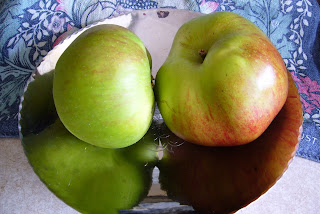Two apples from our cordoned Bramley. These two were from one spur: one pound two ounces and thirteen ounces.
Some time ago, I tried to install a site-meter, and was dismayed to find that it e-mailed each week to inform me that no one had visited - again.. How could this be, when I have two sisters and at least one colleague known to follow my blog?
Last week, I discovered the Stats section of Blogger for the first time and was astonished to find that someone in Turkey has visited many times, along with visitors from India, Greece, Switzerland, Thailand.... I hope that they were not disappointed.
Now, I have four followers, which I find very flattering, as I only follow two blogs and have a number of others on my Favourites list.
Recent posts have touched on the Celtic knotwork of the early 90s in knitting. This quilt which is on the bed in our spare room, has a long history. Some twenty-three years ago we had a snow-day - a rarity for us. I intended to make it memorable and spent it cutting out the pieces for this Dresden plate patchwork, not thinking of it as a quilt.

Once the blocks were completed and assembled, I thought to add wadding and backing. Then I tried some simple outline quilting and discovered the template for the cabled sashing.
The navy valances needed some support from quilting. Never one to be underambitious, I tried the feathered ring, without grasping how to place the template accurately.
At that time, I realised two things: the wadding I had chosen was much too thick for hand-quilting and I didn't like getting my fingers needled so often.
I bought some Celtic quilting patterns from Ally Pally and I improvised some others by photocopying and enlarging, in one case a ceramic keyfob. Celtic knotwork was in vogue at the time, on brooches and scarves. I repeated patterns up each side.
Eventually, I had completed all but one roundel. At this point Christmas visitors were expected, so I finished the edges without doing the final block. That's how it remains, because that is the most complex block.






.JPG)


















.JPG)